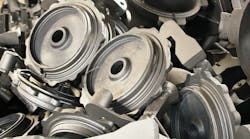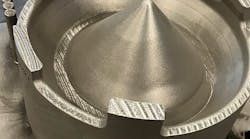Rammable conductive lining has a lower resistivity than other carbon and ceramic materials — speeding relines.
Faster induction furnace turnaround during system relines, and the ability to make repairs more easily to particular areas in between relines, are two advantages of Rammable Conductive Lining (RCL), a "completely new concept" in materials technology for induction heating systems. Morgan Molten Metal Systems (www.morganmms.com) describes it as "a focused program of materials development ... to create a complex functional materials technology that can couple with standard frequency induction fields in the unfired state." RCL can be rammed in place and fired without emitting noxious fumes, without the need to pre-condition the lining, without thermal shock issues, and without degradation of the lining during use through oxidation.
Firing occurs when the current is applied in an induction heater. Eddy currents, which are induced in the electrically conductive material, provide enough heat to cure and fire the material simultaneously, without the need for protective glazes.
The material's resistivity is lower than that of other carbon and ceramic products, and is unique among unfired carbon and ceramic products, which typically have resistivities much too high to couple with induction fields at normal frequencies. Not only do these characteristics allow faster turnaround when relining an induction system, but because the electrical characteristics of the unfired RCL are similar to the fired material, areas of the lining that show wear can be repaired, extending the time between full relines.
Because RCL is placed in-situ, induction system designers can optimize coil design without the constraints of lining shape or geometry. This also means that designs for molten-metal handling are no longer constrained to an existing pre-formed crucible shape.
Because RCL works by heating up the lining to indirectly heat the charge, it also allows furnace designers to exploit induction technology for metals and materials that are poor susceptors (e.g. aluminum.)
For the complete presentation, "A New Lining Material for Induction Melting," read the May 2006 issue, pg. 12.
| Ultra-Low Water Castable for Molten-Metal Applications V-CAST 700 is designed to require 4.5% or less water by weight for casting, though some applications require as little as 3.5%. This results in a denser cast with lower permeability, which Allied indicates improves casting performance because there is greater chemical resistance during the process. Whereas traditional refractory systems use clay bonds the V-CAST 700 series develops an advanced ceramic bond that is "more stable, has superior creep resistance, improves bond strength, and has better corrosion resistance than clay bonded systems." Also, it is designed as a high-purity matrix to maximize performance in corrosive environments. Additives are chosen according to their molten-metal and slag resistance, referencing varying chemistries, and the preparation also incorporates a coarse aggregate blend (up to 25 mm diam.), to enhance the product's thermal shock properties and abrasion resistance. |










